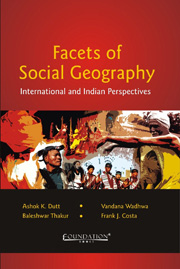Book contents
- Frontmatter
- Contents
- Foreword
- Preface
- Acknowledgements
- List of Contributors
- I Introductory Framework: Allen G. Noble's Contribution to Social Geography
- II Conceptual and Theoretical Basis of Social Geography
- III Social Geography from a Global Perspective
- IV Social Geography in the Indian Context
- 15 Socio-cultural Regions in Pre-historic and Historic India
- 16 Distinct Regional Cultural Identities of India Based on Religion and Language
- 17 Linguistic Diversity Changes in India: A Regional Analysis, 1971–2001
- 18 The Geography of Folk Art in India
- 19 Indian Dance: Classical Unity and Regional Variation
- 20 Space, Gender and Social Value: Analyzing Gender Inequalities in Relation to Space
- 21 Encountering Reservation and the Reimagining of Caste
- 22 Spatial Patterns of Crime in India
- 23 Rural Human Resource Development in India: A Spatio-Temporal Analysis
- V Indian Social Geography: City and State Context
- Index
19 - Indian Dance: Classical Unity and Regional Variation
from IV - Social Geography in the Indian Context
Published online by Cambridge University Press: 05 June 2012
- Frontmatter
- Contents
- Foreword
- Preface
- Acknowledgements
- List of Contributors
- I Introductory Framework: Allen G. Noble's Contribution to Social Geography
- II Conceptual and Theoretical Basis of Social Geography
- III Social Geography from a Global Perspective
- IV Social Geography in the Indian Context
- 15 Socio-cultural Regions in Pre-historic and Historic India
- 16 Distinct Regional Cultural Identities of India Based on Religion and Language
- 17 Linguistic Diversity Changes in India: A Regional Analysis, 1971–2001
- 18 The Geography of Folk Art in India
- 19 Indian Dance: Classical Unity and Regional Variation
- 20 Space, Gender and Social Value: Analyzing Gender Inequalities in Relation to Space
- 21 Encountering Reservation and the Reimagining of Caste
- 22 Spatial Patterns of Crime in India
- 23 Rural Human Resource Development in India: A Spatio-Temporal Analysis
- V Indian Social Geography: City and State Context
- Index
Summary
In the social environment of rigid hierarchy, the performing arts of India served to bridge the gap between the intellectual Sanskritic tradition and the popular folk tradition. Ancient Brahminic tradition forbade Sanskrit learning to the non-initiates, that is all those who were not ‘twiceborn’. This restriction applied to all women generally, including those from the brahmin caste. Although the so-called ‘high tradition’ kept its doors closed against intellectual pursuits by common people, the latter enjoyed some measure of spiritual experience through theatre, dance, folklore, oral literature and other aesthetic media.
The most respected scripture of dance and drama, the Natyasastra, written by the Sanskritic scholar, Bharata, is so fundamental that it has become known as the fifth Veda. Dancing, like other arts, became recognized as a spiritual experience. In fact, the performing arts provide a source of religious education to the common people, as well as serve as channels for mass communication of moral and ethical values, gained through commonly shared aesthetic experience.
The dance theatre of India represents a blending of ‘high’ and ‘folk’ traditions. All classical schools of Indian dance rely on the textual foundation of the scriptures, either of Bharata or of Sanskritic scholars. Dance gurus often refer to these texts in order to defend and protect their art. In fact, the very word ‘classical’ has some prestige attached to it, inasmuch as it signifies closeness to the ‘high’ tradition.
- Type
- Chapter
- Information
- Facets of Social GeographyInternational and Indian Perspectives, pp. 367 - 381Publisher: Foundation BooksPrint publication year: 2012



